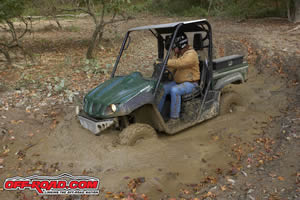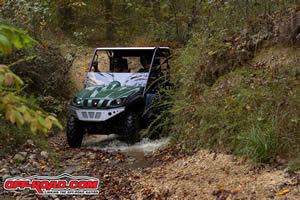|
Another invitation from Yamaha arrived shortly after the new
Wolverine story was completed. This time we will be joining Yamaha
in the beautiful state of Kentucky, visiting the land between the
lakes area and staying at the Green Turtle Bay Resort, located on
Lake Barkley. We test drove the new 2006 Rhino 450
along the banks of lake Kentucky and on the wooded trails of the
Turkey Bay riding area. Off-Road.com is excited to bring you news
of the new Yamaha Rhino 450. This unit is a direct decedent of the
Rhino 660. The Rhino 660 was first introduced in 2003 as a sporty
side-by-side utility ATV with a cargo-box. Powered by the
already-proven Raptor 660 engine, the original Rhino was quite
impressive. The Rhino side-by-side ATV quickly became well-accepted
by the outdoors community, for hunting, fishing, trail riding and
working in the outdoors. New for 2006 Yamaha introduces the Rhino
450. This unit uses the same chassis, frame and body. The only
features that have changed are the engine size and a reduction in
gearing within the automatic transmission. AND a more-affordable
price tag, going from $9,199 with the 660 version to $7,999 on the
450 - that’s a $1,200 savings. We started our day with a
short presentation from Steve Nessl, ATV Public Relations Manager
for Yamaha. Steve gave our media group some information on the new
Rhino, explaining the market segment that the new Rhino 450 hoped
to reach and pointed out the price of the Rhino 450 is similar to
many top-of-the-line single rider traditional ATVs on the market.
Engine This is the same power-plant used in the
now-available Kodiak ATV, the 421 cc liquid cooled two valve
engine. Yamaha decided to use the configuration because of the
engine's vast amount of low-end torque and mid-range power, making
it the perfect choice for a smaller version of the original Rhino.
Mated to the 450 engine is Yamaha’s tried and true Ultramatic
automatic transmission with high, low, neutral and reverse. One of
the only changes made to the basic components of the new Rhino is
here. Yamaha changed and lowered the high and low gear ratio in the
original Kodiak Ultramatic to increase the power level needed in a
side by side application. A few other features that have trickled
down from the Grizzly into both the Kodiak and Rhino are the
On-Command Four-Wheel drive and the fully independent suspension.
Let’s start with the On-Command four-wheel drive. First we
have a dash mounted switch that enables the driver to in-gauge the
machines four-wheel drive. If that’s not enough traction,
Yamaha has another option. True locking four wheel drive. This
locks all four wheels into a direct drive and produces power to
each wheel. The system may sound complicated but its simple - just
push the first four wheel drive button for four wheel drive. If
that’s not enough, slide the locking lever over and push the
locking differential button. This will engage the fully locked
traction and supply power to each wheel.
The Rhino is set up with each wheel using its own suspension. The
fully independent suspension makes for a better ride and better
traction especially when riding over trail obstacles. The Rhino
uses a double wishbone suspension with 7.3 inches of wheel travel
and 5-way adjustable shocks, both in the front and the rear of the
unit.
Ride Time The Rhino 450 comes from an
already-proven product both in engine and design. But one question
was still on my mind, ”How does the unit perform?”
Everyone was excited to hit the trail and find out for ourselves.
Typically most manufacturer rides start with a driver’s
safety meeting - they like to make sure that less experienced
riders know and understand how to safely operate the product. After
all, the Rhino looks like a jeep or automotive type vehicle with
its operator’s controls. The steering wheel, brake, gas
peddle and center consol shift handle each look and operate quite
similar to an automotive application. Only, this type of vehicle is
not designed for the pavement. Instead its design is specifically
made for off-road riding. That means mud, steep hill climbs logs,
rocks and water are all part of the typical day on the trail. A
short drivers meeting was given by Yamaha’s Pat Biolsi. He
explained some of the Rhino features and talked a bit about safety
of the Rhino. Getting Dirty
 |
We already know the Rhino 450 uses the same engine and transmission
from the Kodiak but there are plenty of other components that come
from the slightly-sportier Grizzly, such as the rear differential
and front differential with in and out and locking four
wheel-drive. The rear suspension uses a hefty sway-bar with extra
attention being placed on control, features such as a rack and
pinion steering, u-joint steering linkage and the low center of
gravity make this unit corner nicely. Couple that with a chassis
that closely resembles a Hummer stance, boasting a fully
independent front and rear suspension and you have a
larger-than-life two seat ATV, although, due to weight issue, the
unit isn't generally classified as a true ATV. The Rhino uses the
already proven fully automatic, Ultramatic transmission with
excellent engine braking. The cockpit has some of the best seating
we have ever focused on and positioning gives easy access to the
steering wheel. Optional LCD instrument panel and automotive-style
console shifting handle. That’s not all - the Rhino supplies
sufficient floor space and plenty of leg room. Floor controls
include a gas and brake pedal. Nothing uncomfortable about these
controls. Easy access to the engine is gained by removing the
center console cover. Wow, servicing has never been easier - the
air and oil filter are in plan view. The Rhino’s mud
protection is quite good with large front and rear fenders and
inner mud guards. Let’s not forget the optional front window
and roof to help keep the cold weather off the occupants.
 |
Ok, now we know the Rhino has all the necessary hardware, but what
about ground clearance? How about 12.1 inches of rock clearing,
stump crawling ground clearance! Not bad, right? Consider full
underbelly protection and all-new Maxxis 25x8-12 aggressive tires
front and 25x10-12 aggressive tires rear. Another great feature is
the factory stock, heavy-duty front bumper and CV guards for extra
protection. And check Yamaha Accessories for plenty of different
items to customize your Rhino. Final Impressions
Rider confidence was incredible, I felt like I was in total control
and if I pushed the unit a bit too high or off-camber, I felt I
could quickly shift into reverse and power out of the situation. I
must say, Yamaha has done a great job of keeping the mass of weight
low and in the center of the Rhino producing excellent control and
feel on the intense angles. The new Maxxis tires are great - they
enable the Rhino to put that true four-wheel drive traction to its
fullest capacity.
This was a great new model to test. The unit never
left us down and always had us asking for more ride time. The only
difference between the 450 and it's predecessor was in off-the-line
acceleration and top speed - the 450 had a lower top speed of 37
mph, whereas the 660 can reach somewhere in the area of 47 mph.
We are excited to see a quality side by side unit coming in at a
more-affordable price, especially when today’s ATVs are
priced higher than ever before. Consider top of the line ATVs are
marked at $7,000 to $8,000 and up - I’m glad to see a more
diversified unit such as the Rhino 450 coming in with an $8,000
price tag. Especially when I know how handy the side by side cargo
box unit can be when hunting, fishing, planting wildlife
food-plots, or just plain having fun with a friend! Perhaps the
most interesting news yet on the Rhino is that the Rhino concept
was originally thought of and designed here in the USA - that may
be a first for a Japanese company.
Bottom line, we found the new Rhino 450 to be surprisingly
powerful, very aggressive, easy to use and fun. The price
is a great point when looking at an ATV, especially when you
realize two can ride for the price of one.
Yes, this is smaller than its big brother but by
no means is it under-powered. I think more off road enthusiasts are
going to be visiting Yamaha dealers for a look at the Rhino 450.
Check out the Yamaha web-site for more information on their
expanding Rhino accessory list, and check out the new
build-your-our own Rhino section where you can customize your Rhino
and find out how much you want to spend.
-rs
|